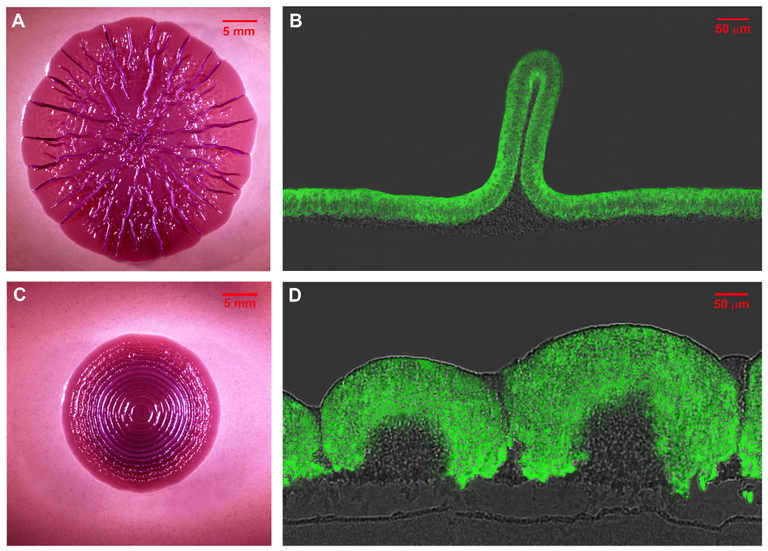.

E. coli Biofilm architecture and morphology
Bacterial macrocolonies on agar plates with complex medium represent biofilms growing on decaying organic materials in nature. This type of biofilm shows a complex supracellular architecture and an intriguing macroscopic morphology that is visible even to the naked eye. In macrocolonies steep gradients of nutrients (coming from the agar) and oxygen (from the air) build up and determine cellular physiology in different zones of the biofilm. Thus, E. coli macrocolonies feature proliferating flagellated cells in the bottom layer and small starving cells surrounded by a self-produced matrix of amyloid curli fibres and cellulose in the top layer (curli and cellulose can be visualized in vertical cryosections with the fluorescent dye thioflavin S). In between a transition zone with heterogeneous matrix production can be observed. The curli&cellulose matrix confers protection, cohesion and elasticity – a macrocolony biofilm in fact shows tissue-like behaviour. This means that under the tension which builds up as a consequence of cellular proliferation and crowding, a macrocolony folds and buckles up like an elastic sheet, thereby generating amazing patterns of high ridges, concentric rings and elaborate wrinkles.
Current work in our group addresses the following questions:
- What are the molecular regulatory mechanisms underlying long and short range heterogeneity of matrix production in macrocolony biofilms?
- How are the amount and ratio of curli fibres and cellulose present in different zones modulated in response to environmental conditions? How does this affect cohesion and elasticity and thereby macroscopic morphology of macrocolony biofilms?
- Why is matrix produced in the upper layer of a macrocolony only?
- What is the physiological function of heterogeneous matrix production in the transition zone?
- How can we use complex morphological patterns as a reliable phenotypic readout for the amounts, ratios and spatial distribution of curli and cellulose?
Serra, D. O., Klauck, G., and Hengge, R. (2015). Vertical stratification of matrix production is essential for physical integrity and architecture of macrocolony biofilms of E scherichia coli . Env. Microbiol., 17, 5073–5088. doi.org/10.1111/1462-2920.12991.
Serra, D.O., and R. Hengge (2014) Stress responses go three-dimensional - the spatial order of physiological differentiation in bacterial macrocolony biofilms. Environ. Microbiol. 16, 1455-1471.
Serra, D.O., A.M. Richter, and R. Hengge (2013) Cellulose as an architectural element in spatially structured Escherichia coli biofilms. J. Bacteriol. 195, 5540-5554.
Serra, D.O., A.M. Richter, G. Klauck, F. Mika, and R. Hengge (2013) Microanatomy at cellular resolution and spatial order of physiological differentiation in a bacterial biofilm. MBio 4(2), e00103-13.
